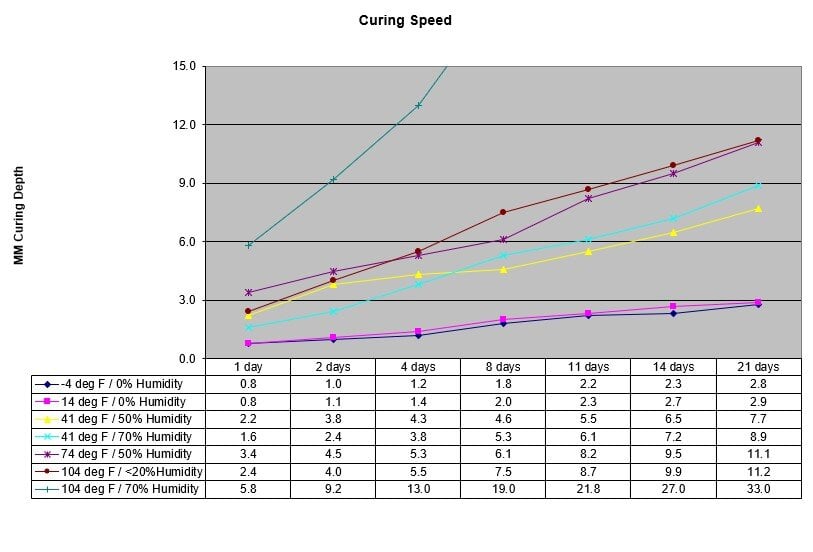Research & Development, Application Processes, Industrial, Products
Cure Time, Skin Time & the role of ambient temperature
Most Seal Bond® products are formulated with moisture curing technology that reacts with atmospheric moisture to initiate chemical cross-linking of the ingredients. As the ingredients cross-link the sealant or adhesive builds internal strength and creates a chemical bond to the substrates. The amount of time that this process takes depends on many factors including the specific chemical composition of the formula and several environmental factors. In this article, we will break down the terminology and key factors that determine the cure rate of our products.
Full Cure
An adhesive or sealant is said to have reached full cure when the chemical reaction is complete, and the ultimate strength has been reached. For many single component chemistries, this process can take days or weeks to complete. Depending on the application, the time to full cure may be more or less important. For example, in the installation and assembly of raised access flooring the adhesive must be fully cured before flooring can be occupied. However, in many product assembly applications, a fully cured adhesive is not always required to complete the fabrication process. In these cases, a “functional or workable cure” is reached when the adhesive or sealant has skinned over.
Skin Time
Once exposed to atmospheric moisture, our adhesives and sealants begin curing from the outside in. “Skin time” measures the time between application and the formation of the skin as the outermost layer cures. As the skin develops, the applied adhesive or sealant rapidly loses its ability to bond to secondary substrates and is more difficult to tool.
Tack Free Time
“Tack free time” is when the surface of the glue ceases to be sticky… which also prevents “pickup” of dirt or debris that could otherwise discolor the exposed product. “Tack free time” and “skin time” are not quite the same thing; we define the skin to have formed at the point where no adhesive will transfer when touched… but there can still be stickiness or tack after the skin has formed. With some products, tack will remain indefinitely, for others, it goes away as the adhesive or sealant cures.
The ideal skin time varies for different uses and a shorter skin time is not always better. For example, in some manufacturing processes, it is beneficial to have a greater window of time to apply the secondary substrate. In these applications, skin time may be referred to as “open” or “working” time as that is what drives the functional requirement of the adhesive. Skin time is typically measured at 70o F and 50% Relative Humidity to provide a standardized measure.
Factors that determine cure or skin time
Outside of the chemical composition, cure time is most impacted by the temperature at the time of application and throughout the curing period. Relative humidity has some impact on the rate of cure but generally, as long as moisture is present, the increasing temperature is the primary factor that will increase the cure rate. See the chart below that illustrates the skin time for a given product across temperature ranges from -4oF to 104oF.

Seal Bond has decades of experience optimizing products to meet specific cure requirements and our sales and customer service teams are always available to help select a product that best suits your specific application.
Recent Posts
Archives
- August 2024 (3)
- September 2024 (3)
- October 2024 (3)
- November 2024 (3)
- January 2019 (2)
- January 2025 (2)
- March 2025 (2)
- May 2025 (2)
- October 2015 (1)
- February 2019 (1)
- March 2019 (1)
- April 2019 (1)
- May 2019 (1)
- June 2019 (1)
- July 2019 (1)
- August 2019 (1)
- November 2019 (1)
- December 2024 (1)
- February 2025 (1)
- April 2025 (1)
- June 2025 (1)
